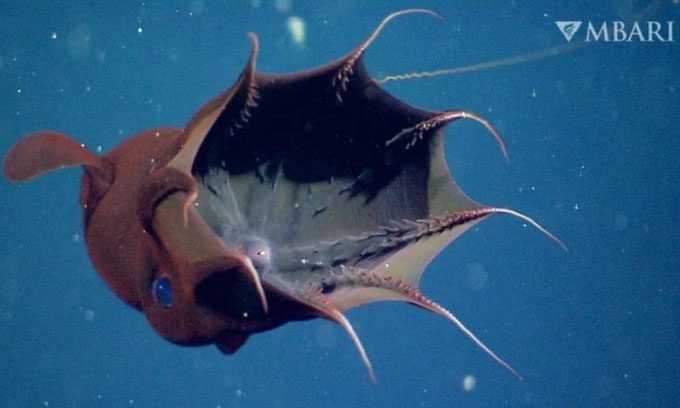Paleontologists Discover a New Species of Vampire Squid That Died with Two Fish in Its Mouth 183 Million Years Ago.
The newly discovered squid species, named Simoniteuthis michaelyi, is a remarkably well-preserved fossil with its prey in its grasp, according to a study published in the Swiss journal of paleontology, as reported by Newsweek on February 26. According to Ben Thuy, a paleontologist at the Luxembourg Natural History Museum (LNMNH), this discovery is incredibly fascinating, showcasing an extremely rare interaction between predator and prey preserved over time.

Simoniteuthis michaelyi resembles today’s vampire squids. (Photo: MBARI).
Vampire Squids (Vampyromorph) are a class of cephalopods that includes octopuses, cuttlefish, and many other relatives. Vampire squids closely resemble squids but are more closely related to octopuses, possessing eight arms instead of ten. Several extinct species of vampire squids have been discovered, indicating that they were a significant part of the prehistoric ocean ecosystem. The only living member of this group is the vampire squid from hell (Vampyroteuthis infernalis), which resides in the deep sea.
The prehistoric vampire squid specimen described in the latest study was found during a scientific excavation conducted by LNMNH in May 2022 in Bascharage, southeastern Luxembourg. The specimen is estimated to date back to the early Jurassic period, spanning from 201 to 174 million years ago. According to Thuy, this discovery is a complete cephalopod resembling a squid, retaining remarkably detailed soft parts. The most unusual characteristic of the new fossil is its exceptional state of preservation, which includes structures that are typically difficult to fossilize, such as muscle tissue, ink, or eyeballs.
While Simoniteuthis may resemble modern squids, it has eight arms. The creature is about 38 cm long. Due to the lack of fossil traces of remaining coloration, the research team could only speculate about the animal’s appearance while alive. Based on fossil evidence, scientists know that Simoniteuthis was an active predator. In fact, the fossil specimen, found with two fish in its mouth, indicates it died while consuming its last meal. However, living in an ocean teeming with large fish and marine reptiles, Simoniteuthis could have also fallen prey to other predators.
Simoniteuthis inhabited the shallow coastal waters of what is now central Europe. The exceptional preservation of this creature may be explained by the environmental conditions of the region’s seas. The water at the seabed had low oxygen levels due to the climate and ocean circulation at the time. As a result, the remains of Simoniteuthis were preserved intact rather than being scavenged by decomposers.





















































